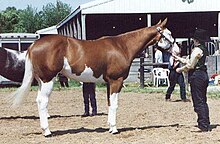Splashed White Overo
Splashed White , also known as SW1 or Nordic piebald , is a spotted coat pattern on the horse, in which colored areas and white in the horse's coat alternate. The white drawing rises from below on the horse, white belly spots, white legs and large white markings on the head as well as blue eyes are typical for this drawing.
Appearance
Heterozygous SW1
Heterozygous animals are sometimes difficult to recognize purely optically. They do not show a check mark and can be monochrome, although they carry the genetic makeup for Splashed White. Others have blue eyes or subtle markings on their heads or legs. Still others have large white head and leg badges. The characteristics can be very different. However, to get a spotted splashed white mark on a horse, the animal must be homozygous.
Homozygous SW1

Only homozygous animals show the spotted fur pattern. They inherited the genetic make-up for this coat color from each parent and pass it on to all of their children.
The drawing can be minimal, medium or maximal. If a homozygous splashed white has minimal markings and little white, one would expect a larger white mark on the head, white leg markings, and at least one small white spot under the belly.
If it is moderate, almost the entire head can turn white. Starting from the belly, the drawing rises from below or typically splits the colored surfaces.
health
If animals have blue eyes due to leucism, it can be assumed that they can see more poorly than horses with normal colored eyes. Obviously, the severity of this disability in blue-eyed horses is so mild that riders cannot read it from the behavior of the animal, but one sees again and again that the animals prefer to close their eyes in bright sunshine in order not to be dazzled.
Paint horse breeders report that animals with alleged splashed white markings are often deaf. These problems are recurrent in some lineages and families. Genetic investigations have shown that it is not the form of Splashed White (SW1) described here, but another drawing that has only been detected in the Paint Horse and is described as SW2.
Mixed forms
In addition to the splashed white gene, a horse can carry other spotting genes. This then creates check patterns that have the characteristics of both original checks. If several drawings are mixed together, maximum drawings can arise that are so pronounced that the horse is completely white. A mixture of Tobiano and Splashed White can e.g. B. produce a perfectly white horse. Sometimes these double-drawn animals also have the last remains of paint on their heads, which look like a hood that is worn between the ears. This coat color is also known as the medicine hat or helmet piebald.
See also
literature
- Malte M. Harland, Allison J. Stewart, Arvle E. Marshall, Ellen B. Belknap : Diagnosis of deafness in a horse by brainstem auditory evoked potential . In: The Canadian Veterinary Journal . Volume 47, Issue 2 . Canadian Veterinary Medical Association , February 2006, pp. 151-154 , PMID 16579041 (English).
- Monika Reissmann: The colors of horses, genetics, classification, characteristics . Cadmos, Brunsbek 2009, ISBN 978-3-86127-460-5 .
Web links
- R. Hauswirth, B. Haase et al: Mutations in MITF and PAX3 Cause “Splashed White” and Other White Spotting Phenotypes in Horses . In: PLOS Genetics. April 12, 2012, accessed October 13, 2014 .
- Splashed white . Veterinary Genetics Laboratory,accessed July 30, 2013.
- Splashed white . In: Morgan Colors . Laura Behning,accessed December 14, 2018.
